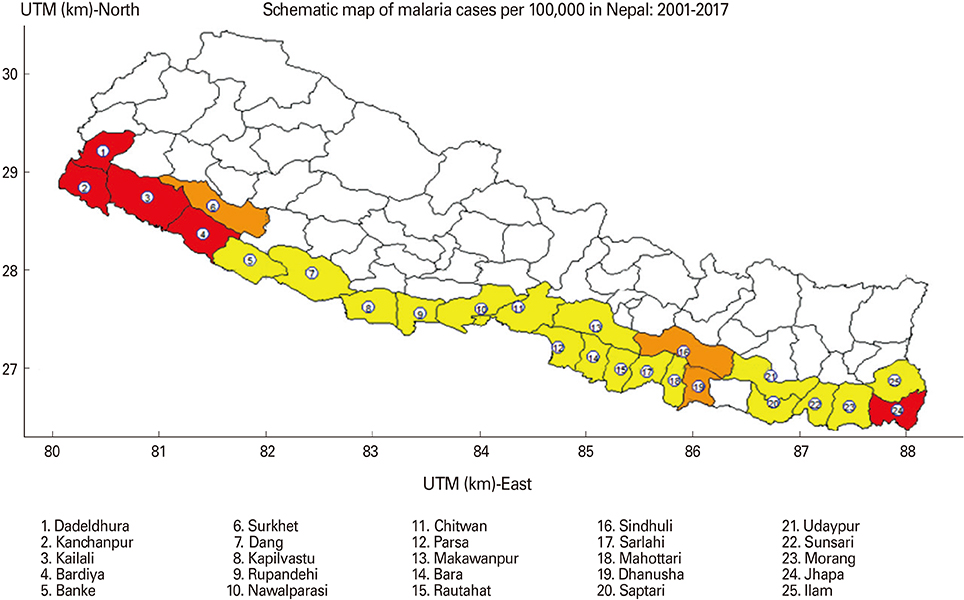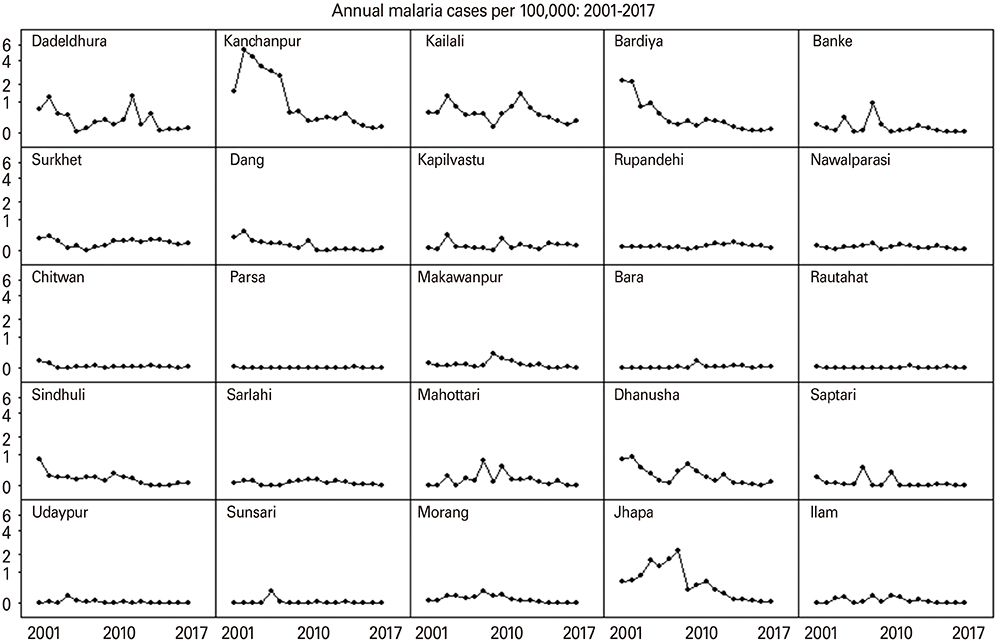Clin Exp Vaccine Res.
2019 Jan;8(1):77-85. 10.7774/cevr.2019.8.1.77.
Patterns and trends of malaria in 25 risk districts of Nepal from 2001 to 2017
- Affiliations
-
- 1Department of Medical and Allied Science, Faulty of Public Health, Karnali College of Health Science, Kathmandu, Nepal. gautamnirmal@karnalicollege.edu.np
- 2Faculty of Science and Technology, Prince of Songkla University, Pattani, Thailand.
- 3Shahid Gangala National Heart Center, Kathmandu, Nepal.
- 4Department of Statistics, Faculty of Science, Kasetsart University, Bangkok, Thailand.
- KMID: 2438971
- DOI: http://doi.org/10.7774/cevr.2019.8.1.77
Abstract
- PURPOSE
Malaria has been one of a major infectious parasitic disease in Nepal. Although the number of cases is gradually getting declined since last decade. Therefore, study aims to identify the trends and spatial patterns of malaria among 25 risk districts of Nepal.
MATERIALS AND METHODS
This study utilized the secondary data of malaria cases from the annual reports (2001-2017) of Department of Health Services, Ministry of Health and Population of Nepal. Linear regression of log-transformed incidence rates model was used for assessing variation of malaria cases for year and districts.
RESULTS
There was evidence of decrease in the trend of malaria (2001-2009); however, the upward trend was revealed in 2010, after that, it starts to decline and again in 2017, it started to grow up. The malaria cases were marked variations by location with higher rates occurring in Dadeldhura, Kanchanpur, Kailali, Bardiya, and Jhapa districts, respectively.
CONCLUSION
In this regards, malaria cases are still causing the threat in the Terai district of Nepal; however, there were fluctuating patterns of disease noted during the study periods.
Keyword
Figure
Reference
-
1. Lopez Del Prado GR, Hernan Garcia C, Moreno Cea L, et al. Malaria in developing countries. J Infect Dev Ctries. 2014; 8:1–4.
Article2. World Health organization. Monitoring health for the sustainable development goal [Internet]. Geneva: World Health Organization;2018. cited 2018 Feb 9. Available from: https://apps.who.int/iris/rest/bitstreams/1137482/retrieve.3. World Health Organization. 2016 World malaria report [Internet]. Geneva: World Health Organization;2016. cited 2018 Apr 19. Available from: http://apps.who.int/iris/bitstream/handle/10665/252038/9789241511711-eng.pdf?sequence=1.4. World Health organization. 2017 World malaria report [Internet]. Geneva: World Health Organization;2017. cited 2018 Apr 19. Available from: http://apps.who.int/iris/bitstream/handle/10665/259492/9789241565523-eng.pdf?sequence=1.5. Gomes E, Capinha C, Rocha J, Sousa C. Mapping risk of malaria transmission in mainland Portugal using a mathematical modelling approach. PLoS One. 2016; 11:e0164788.
Article6. World Health Organization. World malaria report 2015 [Internet]. Geneva: World Health Organization;2015. cited 2018 Apr 5. Available from: http://apps.who.int/iris/bitstream/handle/10665/200018/9789241565158_eng.pdf?sequence=1.7. Dhimal M, Ahrens B, Kuch U. Malaria control in Nepal 1963-2012: challenges on the path towards elimination. Malar J. 2014; 13:241.
Article8. Department of Health Service. Annual report of Government of Nepal [Internet]. Kathmandu: Department of Health Services, Ministry of Health and Population, Government of Nepal;2017. cited 2018 Aug 19. Available from: http://dohs.gov.np/wp-content/uploads/2017/06/DoHS_ Annual_Report_2072_73.pdf.9. Kakchapati S, Ardkaew J. Modeling of malaria incidence in Nepal. J Res Health Sci. 2011; 11:7–13.10. Shapiro LL, Whitehead SA, Thomas MB. Quantifying the effects of temperature on mosquito and parasite traits that determine the transmission potential of human malaria. PLoS Biol. 2017; 15:e2003489.
Article11. Bista MB, Vaidya RD, Banargee MK, Thakur GD. The annual internal assessment of malaria and kala-azar control activities, 2003. Kathmandu: Epidemiology and Disease Control Division, Department of Health Services, Ministry of Health;2005.12. Parajuli K, Ghimire P. Epidemiology of malaria in two Eastern districts of Nepal. Kathmandu Univ Med J (KUMJ). 2010; 8:45–50.
Article13. Singh V, Mishra N, Awasthi G, Dash AP, Das A. Why is it important to study malaria epidemiology in India? Trends Parasitol. 2009; 25:452–457.
Article14. Manandhar S, Bhusal CL, Ghimire U, Singh SP, Karmacharya DB, Dixit SM. A study on relapse/re-infection rate of Plasmodium vivax malaria and identification of the predominant genotypes of P. vivax in two endemic districts of Nepal. Malar J. 2013; 12:324.
Article15. Dhimal M, O'Hara RB, Karki R, Thakur GD, Kuch U, Ahrens B. Spatio-temporal distribution of malaria and its association with climatic factors and vector-control interventions in two high-risk districts of Nepal. Malar J. 2014; 13:457.
Article16. Department of Health Services. Annual report 2069/70 (2012/2013). Kathmandu: Department of Health Services, Ministry of Health and Population, Government of Nepal;2014. cited 2018 Jun 15. Available from: http://dohs.gov.np/wp-content/uploads/2014/04/Annual_Report_2069_70.pdf.17. Ministry of Health and Population. Nepal Malaria Strategic Plan 2014-2025 [Internet]. Geneva: World Health Organization;2013. cited 2018 Feb 22. Available from: http://apps.searo.who.int/PDS_DOCS/B4946.pdf.18. Central Bureau of Statistics. National population and housing census 2011. Vol. 1. Kathmandu: Central Bureau of Statistics, National Planning Commission Secretariat, Government of Nepal;2012.19. Singh KR, Sah RB, Pokharel PK. A study on malaria cases in hilly areas and Terai belt of Nepal. Health Renaissance. 2015; 13:4–12.
Article20. Tongkumchum P, McNeil D. Confidence intervals using contrasts for regression model. Songklanakarin J Sci Technol. 2009; 31:151–156.21. Venables WN, Smith DM. The R Development Core Team. An introduction to R. Vienna: R Foundation for Statistic;2008.22. Benoit K. Linear regression models with logarithmic transformations. London: London School of Economics;2011.23. World Health Organization. World malaria report 2013 [Internet]. Geneva: World Health Organization;2013. cited 2018 Feb 22. Available from: http://www.who.int/iris/bitstream/10665/97008/1/9789241564694_eng.pdf.24. Maxwell CA, Chambo W, Mwaimu M, Magogo F, Carneiro IA, Curtis CF. Variation of malaria transmission and morbidity with altitude in Tanzania and with introduction of alphacypermethrin treated nets. Malar J. 2003; 2:28.25. Rural Access Programme. District profile of dedeldhura [Internet]. Jawalakhel: Rural Access Programme;2016. cited 2018 Feb 17. Available from: http://rapnepal.com/district/district-profile-3.26. Poertner E, Junginger M, Muller-Boker U. Migration in far west Nepal: intergenerational linkages between internal and international migration of rural-to-urban migrants. Crit Asian Stud. 2011; 43:23–47.27. Thieme S, Kollmair M, Muller-Boker U. Labour migration from Far West Nepal to Delhi, India. Eur Bull Himal Res. 2003; 24:82–89.28. Epidemiological Disease Control Division. Nepal malaria report 2010–2012. Kathmandu: Epidemiology and Disease Control Division, Department of Health Services, Ministry of Health and Population, Government of Nepal;2013.29. World Health Organization, Regional Office for South-East Asia. Nepal malaria programme review [Internet]. Geneva: World Health Organization;2010. cited 2018 Feb 26. Available from: http://apps.searo.who.int/PDS_DOCS/B4673.pdf.30. Nobre AA, Schmidt AM, Lopes HF. Spatio-temporal models for mapping the incidence of malaria in Para. Environmetrics. 2005; 16:291–304.
Article31. Epidemiological Disease Control Division. Nepal malaria strategic plan 2011–2016 (revised version, December 2011). Kathmandu: Epidemiology and Disease Control Division, Department of Health Services, Ministry of Health and Population, Government of Nepal;2011.
- Full Text Links
- Actions
-
Cited
- CITED
-
- Close
- Share
- Similar articles
-
- A small window into the status of malaria in North Korea: estimation of imported malaria incidence among visitors from South Korea
- Review of brucellosis in Nepal
- Status of Vivax Malaria in the Republic of Korea
- Malaria Risk Factors in Kaligesing, Purworejo District, Central Java Province, Indonesia: A Case-control Study
- Genetic Polymorphisms in Plasmodium vivax Dihydrofolate Reductase and Dihydropteroate Synthase in Isolates from the Philippines, Bangladesh, and Nepal





